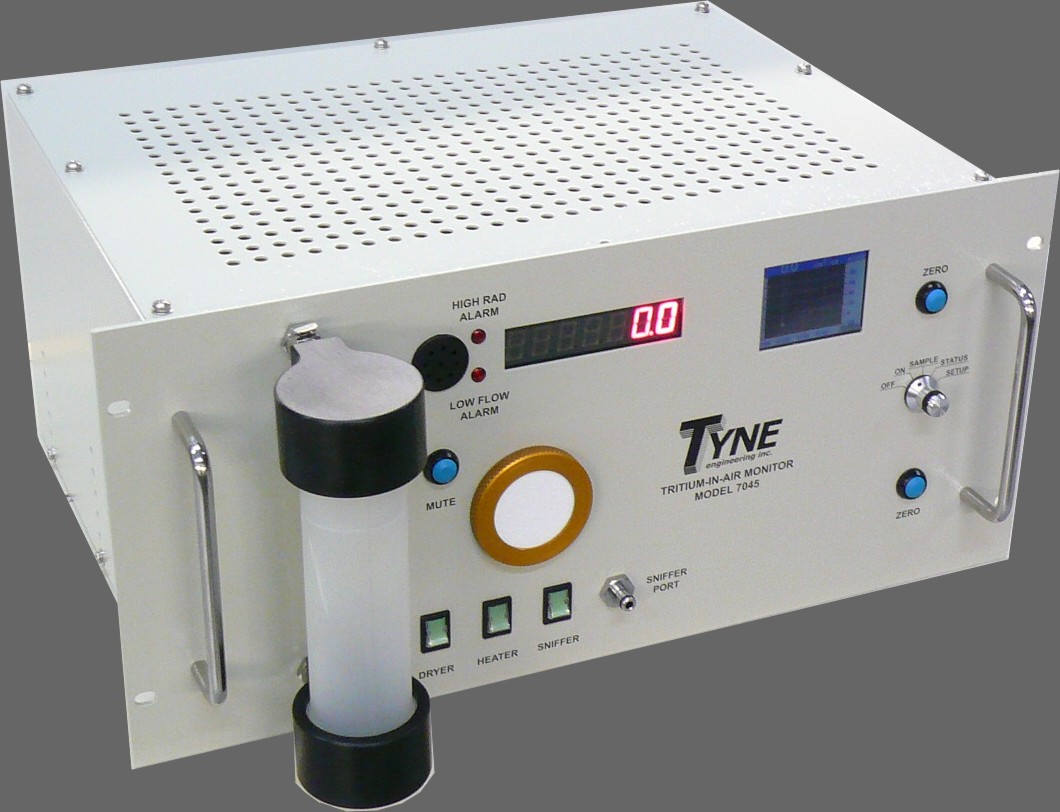Room Tritium-in-Air Monitor
Model: 7045
Application
Tyne Engineering’s new Model 7045 Room Tritium In-Air Monitor is a wall or rackmount version of our popular Model 7043 Portable Tritium Monitor. The 7045 is intended for room monitoring for both tritium and gamma.
Features
-
Simple to use, with only one operating switch with four settings: Off, Sample, Pump, Set Up.
-
Gamma Compensation with four large ion chambers arranged in a cruciform configuration. Two chambers are used for measuring the air sample, and two are for compensation.
-
Less than 10% inaccuracy in 20 mR/hr field
-
High Sensitivity. The current amplification circuit employs ultra-low leakage technology. Each chamber has its individual amplifier, increasing the Signal-Noise Ratio of the analog circuit.
-
Radon compensation is provided by the analog filter circuit designed to separate the radon spike. The software can distinguish the radon spike from the tritium signal occuring as a slow-change signal.
-
Ion-traps are built into each ion chamber.
-
Noble gas compensation.
-
Direct gamma measurement is provided using an installed GM tube.
-
Decontamination by purging of all 4 ion chambers can be achieved with use of the centrally installed cartridge heater.

Description
Compensation for Gamma background is crucial in tritium measurement, since a gamma field of 1mR/Hr will generate 500 times the ionization generated in 1µCi/m³ of tritium. Tyne designed the four ion chambers in a cruciform with each chamber connected to an ultra sensitive electrometer amplifier and filter. All signals pass through the ADC converter, and the micro-processor calculates and displays the tritium value. To cover high ranges of tritium a separate small ion chamber is used. Measurements such as flow from the solid-state flowmeter and chamber temperature are also monitored by the micro-processor.
Instrument output includes analog (0-5V, 4-20mA); relay alarm contact (30VDC, 1A) for operation of external equipment; and communication (RS232/RS485) to enable downloading or recording of information onto a computer. The TFT full color LCD display mounted on the surface plate clearly displays instrument readings in both digital and graphic format to show real time measurements and trends.
The 7045 instrument is based on the platform of a very successful hand held tritium in air monitor that Tyne manufactures. The differences are that the wall mount version, which can also be put into a 19” rack cabinet is larger. The ion chambers of which there are four, are about 3 times as large as in the 7043 hand held instrument increasing the sensitivity by a factor of three. Additionally the wall mounted instrument has a more powerful long life pump, is accessible for maintenance from the front for such as filter replacement and dryer media replacement, and for attachment of a sniffer probe with a 15 meter reach.
The larger ion chambers, that are provided in a compact package, enable a sensitivity that precludes the need for P-10 gas, which is a nuisance to operators as it must be continuously supplied and the ion chambers also avoid the need for a less reliable flow proportional counting system. The 7045 ion chambers are robust and reliable. If they do become contaminated they can be purged by application of a heater mounted inside the units while continuous flow through the chambers is initiated.
The diaphragm pump for the unit has an EPDM diaphragm, found to be most reliable and long lasting in the field, the pump is quiet and replacement of a diaphragm is simple and takes only a few minutes.
On the front of the unit is mounted a sniffer probe. This is used in the event that the instrument detects a tritium leak, and the operator wishes to sniff round a seal for example which may be suspected of leakage, to help to trace where the leakage is coming from. The sniffer is supplied with a lead that extends up to 15 meters.
The unit has a touch sensitive screen through which settings can be changed and alarm levels set etc. The instrument displays a light in the event that an alarm is activated, and also an audible alarm that can be cancelled without canceling the light. This touch screen panel is actuated by a two level password, one giving access to Health Physics personnel only and another to enable operators to adjust alarms etc. Although the touch screen is ideal for the purposes indicated above, it may not be bright enough to see from across a room, and for that reason a large digital read-out is also provided for better visibility by the operators. The batteries of our hand held version have been replaced in the wall mounted version by power supplies to avoid the maintenance otherwise necessary.
An additional feature of the Tyne instrument is that it is also equipped with a colour changing dryer indicate when renewal is necessary. The dryer enables the operator to evaluate if the tritium measurement is elemental or HTO. In the case of a signal in a moist environment where all tritium will be HTO, the use of the dryer also enables the operator to isolate and alpha signal.
Specifications
| Measuring chamber effective volume | 1.5 L, (2 X 0.75L) |
| Pump | Positive displacement gas pump: 12 VDC, flow rate can be up to 11L/min, continuous pressure 8 psig. |
| Tritium measuring range | 0.2µCi/m3 (7,400Bq/ m3) to 1Ci/m3 |
| 4 chambers | cruciform configuration: two for measuring and two for compensation |
| Radiation measured | measuring total tritium, HTO, gamma and alpha |
| Sensitivity | 0.2µCi/m3 (0.01 DAC) |
| Accuracy | 0.4µCi/m3 from 0 to 100µCi/m3; ±10% from 100µCi/m to 1Ci/m3; |
| Zero stability | ±0.4µCi/m3; |
| Gamma measurement | Gamma is measured simultaneously with tritium. Measuring range is from 0.1mR/h to 10 R/hr; |
| Radon compensation and tritium discrimination | Instrument can provide radon compensation and discriminate in a field of HTO and elemental H3 using the silica gel drier. |
| Gamma background compensation | less than ±10% or 5mCi/m3 reading change whichever is greater response to 20mR/Hr; |
| Ion trap | built into each ion chamber; |
| Flow rate | 0 to 11 L/min |
| Response time | 2 to 5s with 0-15 m air hose, within 20s with hose from 100 to 150m at 90% of signal |
| Stability | : ±3% per 24 hours, ±10% per 30 days; |
| Analog Output | 0-3V linear. |
| Alarms | Tritium, gamma, air flow, detector failure, micro processor alarms in field as well as on optional remote display system through analog output (4 to 20mA) |
| Alarm Response | < 30S with 2-150m hose; |
| Purge decontamination | Chambers can be heated by a cartridge heater controlled by the unit to assist in purging, |
| Condensation Prevention | With heater cartridge temperature can be raised above ambient to prevent condensation in instrument |
| Communication port | RS232 (short distance) and RS485-bus (long distance); |
| Data Logging frequency | The tritium value can be logged every minute and can be time and date stamped. (Gamma is not logged) |
| Displays | One (1) TFT LCD large touch screen display (size 2.8’’), displays the values of tritium, gamma in both numerical and graphical format; one LED screen ¾’’ letters, 7 letter screen. |
| Power supply | 220VAC (±10%); Power consumption < 1A |
| Drier | silica gel cylinder is provided with the unit; |
| Temperature operation range | 0 to 50ºC degree; |
| Humidity operation range | 0-90% Non-condensable |
| Size | Approx 9"High x 12"Deep x 19" Wide; |
| Weight | Approx.: 55lb; |
| Mounting | Unit is designed for table-top, 19” rack, or wall-mounting (bracket optional) |


